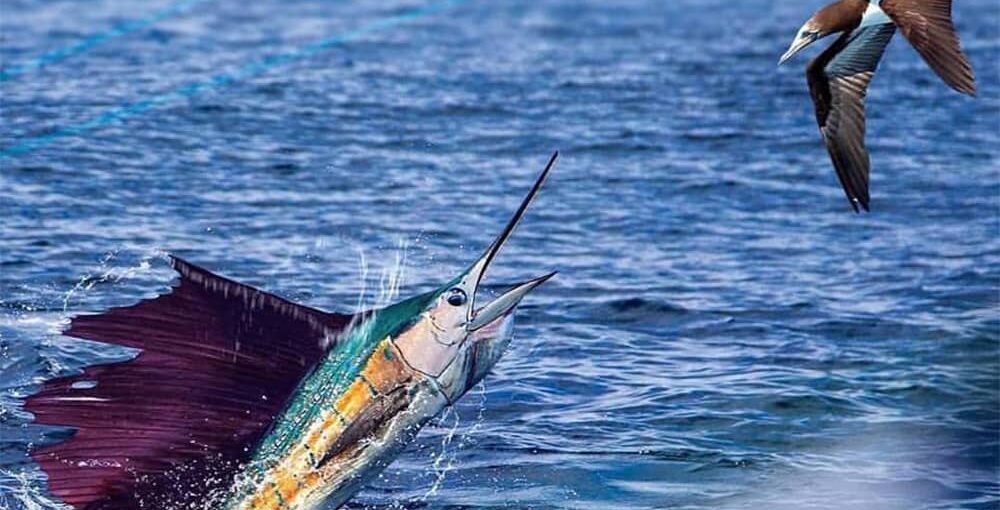Thanks to public pressure from Congresswoman Kattia Cambronero and FECOP, the sport fishing lobby group in Costa Rica, the country´s fisheries governing board, Incopesca reacted in record time to reverse the suspension of the regulation that would of allowed all commercial fleets catch bait in Costa Rica’s three Pacific gulfs.
The suspension of the regulation would have also allowed all commercial fleets to use live baits in a 30-mile zone from the coast that would have drastically increased the incidental killing of tons of sailfish. In the old regulation, catching bait in the gulfs and using it within 30 miles of the coast was reserved for the sport and tourist fishing sector to be used on single hook rod and reel gear only.
Historically Incopesca will make a “temporary” decision until a subject can be studied and then take years to get around to making the actual study. This time the reaction came in record time. The regulation was re-written to add the artisanal fleet permission to gather bait in the gulf but not be able to use it on surface gear, only bottom longlines. Their fishing licenses allow them to fish inshore and up to 3 miles off the coast.
A Google translation of the new regulation reads like this:
Article 4. A prohibition zone is established for the commercial fleet to fish and store bait in nurseries. except tourist fishing and small-scale fishing; as well as sport fishing, except in the Marine Fishing Areas Responsible who so authorizes it; according to the following demarcation and characteristics:
a. In the Golfo Dulce from an imaginary line between Cabo Matapalo and Punta Banco and from this line waters inward to the end of Golfo Dulce (towards Rincón de Osa, to vessels that do not have the respective fishing permits in force for this purpose.
b. In the Gulf of Nicoya from an imaginary line between Punta Peñón and Negritos Island and from this line inland to the mouth of the Tempisque River to those vessels who do not have the respective fishing permits in force for this purpose.
c. In the Gulf of Papagayo from an imaginary line between Cabo Velas to Punta Blanca and from this line waters inside, to those vessels that do not have the respective fishing permits in force for this purpose.
Article 5: In areas outside the areas created in sections a, b, and c, of article 4 of this regulation, in a delimited area by an imaginary line parallel to the coast from the high tide line to 30 miles out of the Pacific Ocean.
Costa Rica, the carrying out of commercial fishing operations, using surface longline (long line) with bait, is prohibited live as fishing gear, to commercial fishing fleets, small scale, medium scale and advanced as it will be considered as fishing aimed at the capture of Sailfish.
Both the tourist and small-scale commercial fleet that does not use surface longline fishing as fishing gear are authorized as well as sport fishing, to carry out fishing activities using live bait within those 30 miles, in accordance with your navigation autonomy in accordance with the conditions and specifications authorized by your current fishing license.
In the 30 miles indicated in the first paragraph of this article, the vessels belonging to the commercial fishing fleet of medium scale and advanced commercial fishing will be able to capture bait in authorized sites and transport it in nurseries for use in the boat’s own fishing tasks, they will never be able to carry out fishing activities with live bait using surface longlining within the 30 miles established in this regulation.
2-Repeal the Board of Directors Agreement AJDIP/190-2023, having fulfilled its purposes.
3-In the rest, Agreement AJDIP/280-2014 and its reforms remain intact.
4-Firm Agreement. Please communicate this Agreement to the National Coast Guard Service, National Animal Health Service, Ministry of Environment and Ministry of Public Security, for their powers.
The quick action keeps the medium and advanced fleet of long liners from using live bait within 30 miles of the coast.
But is it really time to celebrate?
Incopesca is famous for making regulations with loopholes big enough for an ocean freighter to pass through. Shark finning was a perfect example. The regulation was made so that all sharks landed must have their fins attached with the supposed purpose to keep longliners from finning sharks and discarding the bodies and only selling the premium dollar fins.
A fisherman was caught taking the fins from large sharks and sewing them on the bodies of small sharks as too not take up storage area on the boat. When his case went to court the case against him was dropped because the regulation said “fins attached” but did not stipulate how and sewing them on was accepted as to being within the regulation.
The new live bait ruling leaves some loopholes to consider. They talk about permissions but don´t stipulate what they are. They also don´t say if the artisanal fleet can only catch bait for personal use. There has been a problem in the past of them catching live bait and selling it to the longliners. Those questions need to be answered.
Also some bad actors in the artisanal fleet but not all is more a part of the sailfish decline than I realized. I want to publicly apologize to the longline fleet as I put the sailfish decline entirely on their shoulders.
Currently there are between 16,000 to 19,000 sailfish killed each year that are reported and many more not reported that are taken as bycatch and sold on the National market by the longline fleet. By law if they are alive on the long line they must be released but most of the time they are harvested anyway because even a small profit to a commercial fisherman is money.
Their reported catch is less than 4% of their total catch. Some spin doctor will take this paragraph and say on social media I was wrong about longliners and apologized. What I am actually saying is my investigations have shown the problem is much worse than I originally thought but not entirely the responsibility of the longliners.
What I learned was a small percentage of the artisanal fleet is also responsible for the intentional slaughter of many sailfish which many do not get reported because most of the artisanal fleet’s fish landing almost never get inspected. This brings the annual of sailfish killed in Costa Rica each year well over 20,000. The fishing license for artisanal boats only allows them a three mile limit from shore but they sneak out further and illegal use surface lines for dorado and sailfish.
The reversal of the temporary study period by Incopesca of the regulation study period is the fastest I have seen Incopesca act in 30 years. First we need to know the difference between a decree, a regulation and a law. A decree is made by the president and may be changed or eliminated by the next president.
A fishing regulation is made by the board of directors of Incopesca and can be changed or eliminated by the stroke of a pen by Incopesca’s board of Directors we have just seen, and a law is proposed by a congressperson, debated, passed or failed by vote of the entire congress and if it passes the only way to change it is to repeat the process which is a long process and does not happen from one day to the next. A law supersedes decrees or regulations.
A proposed law to stop the sale. of sailfish in Costa Rica is in congress right now. Now commercial fisherman use a regulation of Incopesca that allows up to 10% of their catch can be sailfish and sold on the National market.
Congressman Eli Feinzaig presented to the legislative a new project under Expedient 23,463, * “Law to promote the economic development of the coasts: Declaration of sailfish as a national symbol of economic development, social and cultural of Costa Rica” and ends the sale of sailfish in Costa Rica. By the way Costa Rica is the only Central American country that legally allows the sale of sailfish.
The bullet we just dodged is a perfect example of changes that can happen with the stroke of a pen and why we should support this law.






















